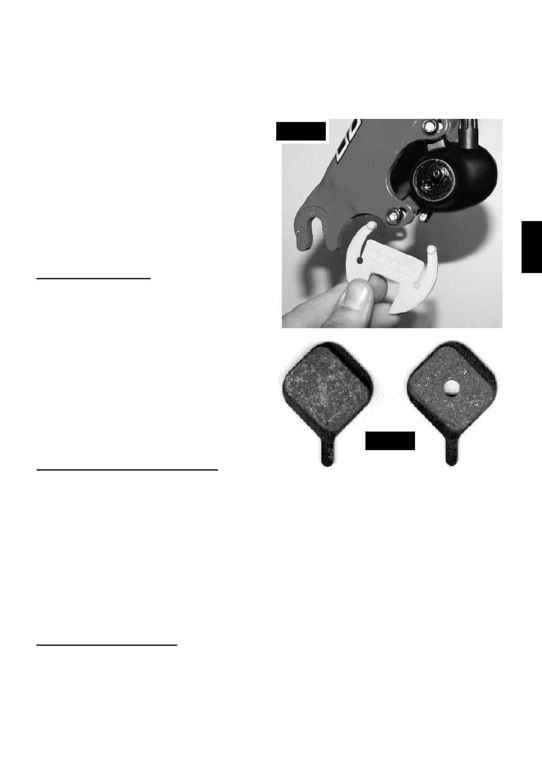
2. If the pads have been previously bedded in to the rotors and are simply being readjusted after
brake bleeding or service, you should still screw in the fixed side pad adjuster just until it begins to
slightly brush the rotor and then back it out counter-clockwise by quarter turns until the brushing
sound stops. The fixed side pad must be set very close to the rotor for optimal brake power. Then set
the piston side pad for desired brake lever travel and feel.
3. Check that the brakes work well and that all
parts and brake lines are tight and secure before
riding. Ride cautiously at first while you get used to
your new brakes, as hydraulic disc brakes have
very different braking characteristics than cable-
actuated rim brakes. Remember that new pads will
require 30-40 full stops to achieve full stopping
power. The bedding-in process can be accelerated
by first riding 200-300 meters slowly around a flat
smooth area (such as an empty parking lot) with
the brakes applied so that they drag. Then make
20-30 full stops from about 10 miles / hour (15.5
Km / h).
BRAKE PAD RETAINER
Whenever the wheel is removed from the bicycle,
insert the CODA Brake Pad Retainer (part #
QC111/) into the caliper to ensure that the brake
pads are not dislodged from the caliper. First,
check to make sure that the pad retainer is clean
and free of oil, grease, or brake fluid. Insert the
edge of the retainer with the wide opening all the
way into the slot in the caliper. The two round
knobs will secure the retainer in the caliper. See
Fig. 5.
Be sure that both pads are in the caliper when
reinstalling the wheel.
BRAKE SYSTEM WEAR INDICATORS
Replace CODA brake pads when they have worn
to the point that the caliper piston pin hole goes all
the way through the pad (see Fig. 6.)
The CODA rotors are also subject to wear and need to be replaced when they are .068" (1.73mm) or
thinner. When new they measure .078" (1.98mm) thick.
The CODA hydraulic fluid, developed by NASA, is not effected by extreme temperatures and does not
absorb moisture, so does not break down over time.
SECTION II: SERVICE
SHORTENING BRAKE LINES
Note: It is best to shorten the Expert Disc Brake hydraulic line at the brake lever end.
CAUTION: REMOVE WHEEL AND PADS FROM THE SYSTEM BEFORE DISCONNECTING
BRAKE LINES! MAKE SURE THAT THE PADS AND BRAKE ROTOR STAY CLEAN AND FREE
OF OIL, GREASE, AND BRAKE FLUID. BEFORE HANDLING THE BRAKE PADS OR ROTOR,
7.
Fig. 5
Fig. 6
NEW PAD
WORN OUT PAD
